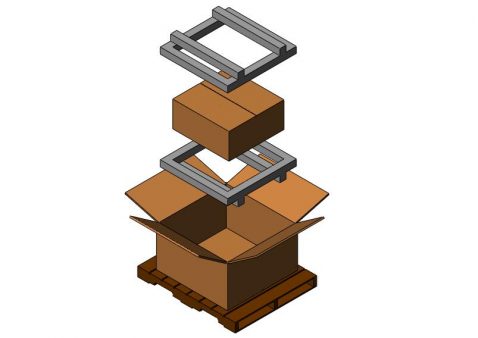Metallic May: Industrial Metal Packaging Solutions Redefined
Metallic May: Industrial Metal Packaging Solutions Redefined
Blog Article
Efficient Industrial Recycling Solutions for Lasting Packaging: A Comprehensive Guide
That's where this comprehensive overview on effective commercial recycling solutions for sustainable product packaging comes in. By discovering key locations such as packaging product selection, developing for recyclability, implementing recycling facilities, working together with recycling partners, and monitoring and measuring reusing success, this overview will outfit you with the knowledge and tools needed to make enlightened choices and drive favorable modification within your organization. Whether you're a packaging expert, sustainability manager, or simply interested in the topic, this guide will certainly give valuable understandings and methods to help you navigate the world of sustainable packaging.
Product Packaging Product Selection
The option of product packaging products plays a critical role in making certain the sustainability of industrial reusing solutions. When it pertains to sustainable packaging, the choice of materials is type in minimizing ecological effect and maximizing reusing performance. Choosing the appropriate materials can help in reducing waste generation, conserve resources, and advertise a circular economy.
Products like cardboard, paper, glass, and specific kinds of plastics can be reused numerous times without shedding their high quality. On the other hand, materials that are difficult to reuse, such as non-recyclable composites or combined plastics, can produce obstacles for the recycling procedure and might finish up in land fills or burners.
Another factor to consider is making use of naturally degradable and sustainable materials. Packaging made from sustainable sources, such as plant-based plastics or biopolymers, can help lower dependency on nonrenewable fuel sources and minimize climate modification. Additionally, naturally degradable materials break down naturally in time, decreasing the accumulation of waste in land fills.
Moreover, the weight and quantity of product packaging materials ought to be minimized to reduce transportation prices and power consumption. Light-weight materials not only require less sources during production but also add to reduce carbon emissions throughout transportation.
Designing for Recyclability
In order to make sure the recyclability of product packaging products, thoughtful style is essential. Designing for recyclability includes creating packaging that can be quickly arranged, separated, and processed in recycling centers. One crucial aspect of making for recyclability is the selection of materials. Product packaging developers should focus on using materials that are extensively accepted for recycling and have actually developed recycling frameworks. Products such as glass, light weight aluminum, and particular kinds of plastic, like animal and HDPE, are commonly recycled and must be chosen over materials that are pricey or tough to recycle.
An additional critical consideration in creating for recyclability is the elimination of unneeded components or products. By lessening the variety of layers, layers, and extra elements, packaging can be made simpler and less complicated to reuse. Furthermore, developers need to intend to minimize making use of mixed materials, as they can complicate the reusing process.

Implementing Recycling Infrastructure
Effective implementation of reusing facilities is important for the success of industrial recycling options. Without appropriate facilities in location, the reusing process becomes ineffective and inadequate, preventing the total objective of sustainable product packaging.
To execute recycling infrastructure effectively, a number of crucial aspects require to be considered. Firstly, there need to be a well-organized collection system that promotes the splitting up and collection of recyclable products. This can consist of designated reusing containers in public areas, along with partnerships with waste administration firms for curbside pickup and sorting.
As soon as gathered, the recyclable products need to be moved to reusing facilities in a prompt anchor manner. This needs effective logistics and transportation networks, making sure that the products reach the appropriate centers right away.
At the reusing centers, progressed sorting and handling innovations must be in area to separate different types of products effectively. This consists of making use of automated sorting machines, optical scanners, and hands-on sorting strategies.
Moreover, there ought to be a durable market demand for recycled materials. This can be achieved with cooperations with suppliers and markets that utilize recycled products in their manufacturing procedures. Producing a steady market for recycled materials incentivizes the recycling market and advertises the circular economic situation.
Teaming Up With Recycling Partners

One key aspect of collaborating with reusing companions is the facility of clear interaction channels. It is necessary to develop open lines of communication to help with the exchange of information, updates, and comments. This permits both events to stay notified regarding the progression of recycling initiatives and attend to any type of challenges or problems that might develop.
Furthermore, cooperation can involve joint initiatives in applying and designing recycling programs. Reusing partners can supply beneficial insights and assistance in creating efficient collection systems and determining one of the most proper recycling technologies. By working together, businesses and reusing companions can optimize the recycling process and reduce waste.
Moreover, cooperation can prolong past the operational elements of recycling. It can additionally encompass campaigning for and education and learning campaigns. By joining forces, organizations and reusing companions can increase recognition regarding the importance of recycling and advertise the fostering of lasting product packaging click to read more practices among consumers and other stakeholders.
Tracking and Measuring Recycling Success
To ensure the efficiency of industrial reusing solutions and the success of sustainable product packaging goals, it is essential for businesses and their recycling partners to establish a detailed system for tracking and gauging recycling success (industrial metal packaging). Tracking and measuring reusing success allows businesses to assess the effect of their reusing initiatives, identify locations for renovation, and set significant targets for future progress
One way to track reusing success is through the usage of data collection and evaluation devices. By collecting information on the amount of product packaging waste generated, the portion of waste that is reused, and the kinds of products being reused, companies can gain important insights into their reusing performance. This data can then be evaluated to recognize patterns, patterns, and locations of inadequacy.
An additional important facet of monitoring and gauging reusing success is establishing clear and standard metrics. This enables organizations to compare their efficiency against sector benchmarks and track their development with time. Metrics such as recycling rates, waste diversion rates, and greenhouse gas emissions can provide a quantitative action of a company's recycling success.

Conclusion
In verdict, executing efficient industrial recycling options for lasting product packaging calls for cautious factor to consider of packaging product choice, developing for recyclability, implementing reusing facilities, collaborating with reusing companions, and tracking and measuring reusing success. By incorporating these techniques, businesses can add to a much more environmentally-friendly and lasting strategy to product packaging, minimizing waste and advertising the circular economic situation.
By discovering vital areas such as packaging material choice, creating for recyclability, applying reusing infrastructure, teaming up with recycling partners, and monitoring and gauging reusing success, this guide will certainly equip you with the understanding and devices necessary to make educated decisions and drive positive modification within your company. Packaging developers ought to prioritize the use of products that are widely accepted for recycling and have actually established reusing frameworks.Cooperation with recycling companions is important for the successful application of commercial reusing remedies and the accomplishment of lasting product packaging objectives. By signing up with forces, companies and recycling partners can increase awareness concerning the value of recycling and advertise the adoption of sustainable packaging practices among consumers and other stakeholders.
By gathering data on the amount of packaging waste generated, the portion of waste that is recycled, and the kinds of materials being reused, businesses can obtain important insights into their recycling performance.
Report this page